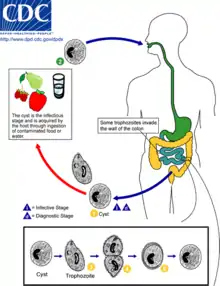Trophozoite
A trophozoite (G. trope, nourishment + zoon, animal) is the activated, feeding stage in the life cycle of certain protozoa such as malaria-causing Plasmodium falciparum and those of the Giardia group.[1] (The complement of the trophozoite state is the thick-walled cyst form).
Life cycle stages

Life cycle of Balantidium coli
Trophozoite and cyst stages are shown in the life cycle of Balantidium coli the causative agent of balantidiasis.
In the apicomplexan life cycle the trophozoite undergoes schizogony (asexual reproduction) and develops into a schizont which contains merozoites.
The trophozoite life stage of Giardia colonizes and proliferates in the small intestine. Trophozoites develop during the course of the infection into cysts which is the infectious life stage.[2]
References
- Yaeger, Robert G. (1996). Protozoa: Structure, Classification, Growth, and Development. Medical Microbiology. University of Texas Medical Branch at Galveston. ISBN 9780963117212.
- Einarsson, Elin; Ma’ayeh, Showgy; Svärd, Staffan G (December 2016). "An up-date on Giardia and giardiasis". Current Opinion in Microbiology. 34: 47–52. doi:10.1016/j.mib.2016.07.019. ISSN 1369-5274. PMID 27501461.
This article is issued from Wikipedia. The text is licensed under Creative Commons - Attribution - Sharealike. Additional terms may apply for the media files.